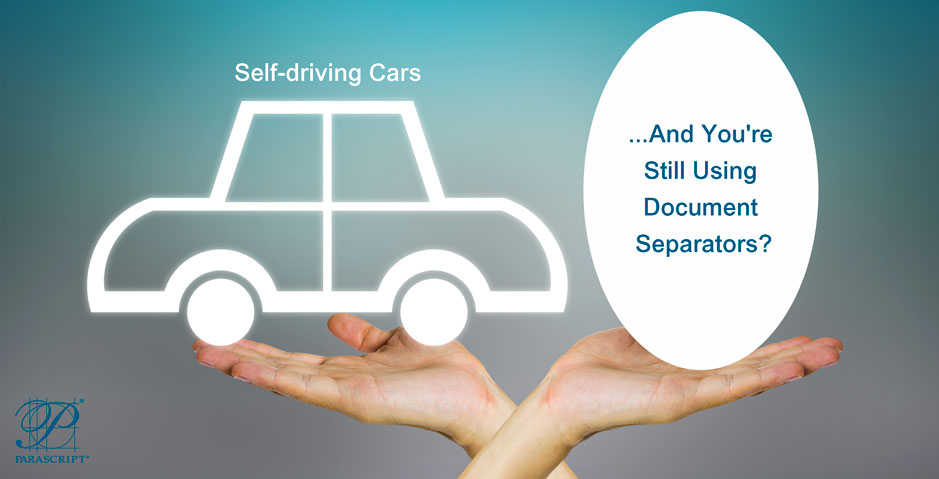Cars that drive themselves–and you’re still using document separators? What’s wrong with this picture?
You have thousands of documents coming in per day or week of different sorts. You have invested in automation for processing documents. In order to do that, your staff routinely reviews and sorts documents by type to make sure either that similar documents are processed together or that a set of documents is all in the correct order before processing. For the former, you need to ensure that the correct documents are fed into your document capture workflow; and for the latter, you probably use separator pages or bar codes on the first page of each document set in order to indicate when a new document or set of documents is starting.
Either scenario likely costs your organization quite a bit of time and the more documents you have, the more time it takes. If you are a business processing outsourcer that manages this document-based information on behalf of clients, it likely costs you significant time, which reduces your margins.
We live in an age of on-demand everything, cognitive computing, and driverless cars. And yet, manually sorting and organizing documents is still the norm. What’s wrong with this picture?
Automating Classification
With automated classification, you don’t have to do any of that. It’s no longer necessary to review and organize documents when they can be fed into a system that automatically identifies a document and then puts it in the correct order, or even identifies the absence of a required document and treats it as an exception so that it follows a different workflow. It’s time to take the next logical step and remove this completely unnecessary manual effort. In traditional document preparation using separator sheets, it takes on average one to two minutes per document batch to prepare. While this may not seem like a lot for an individual batch, multiply this by 100 or more. The potential delays are obvious.
No Hassle Document Prep
With the type of classification we’re talking about, there is no need to create literal rules that look for key words or certain data. This isn’t simply basic vectors based upon word counts. We’re talking about real, machine-learning-based document classification. It extracts text or visual features—or both—and automatically creates logic that can distinguish one document from another document. This document classification implements multiple artificial intelligence techniques to maximize accuracy.
With enough samples, you can achieve document classification accuracy that is the same or better than a human—and the system can do it nonstop, all day long. The documents that can’t be classified can be treated as exceptions. The result: no “document prep” in order to get the level of automation you’ve been needing all this time. No bar codes, no separator sheets, and no hassle. Better yet, this type of automation can be had at a few pennies per page and it is simple to implement.
It’s time to take another look at document classification for no-hassle document prep.

